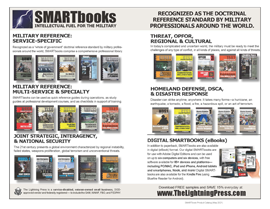Related Books
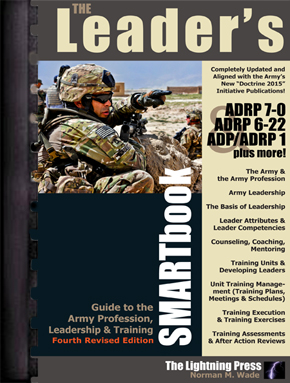
The Leader's SMARTbook, 4th Rev. Ed. (PREVIOUS EDITION)
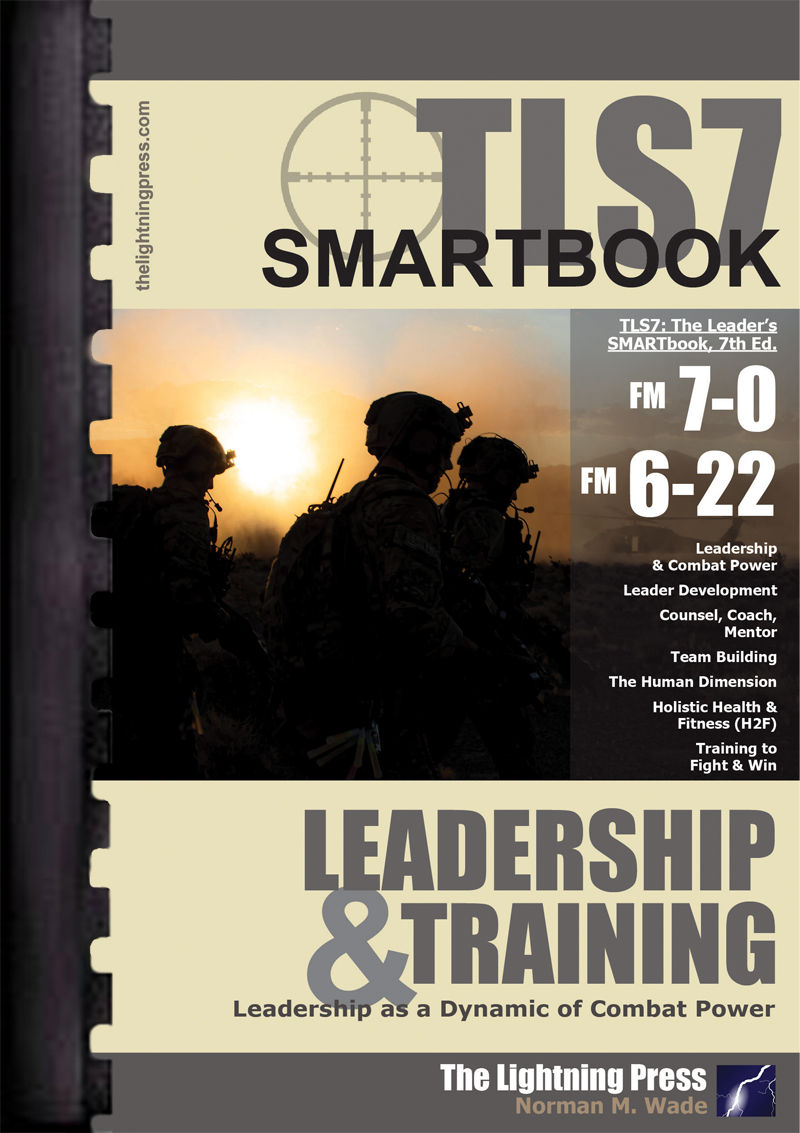
TLS7: The Leader’s SMARTbook, 7th Ed.

SUTS3: The Small Unit Tactics SMARTbook, 3rd Ed.
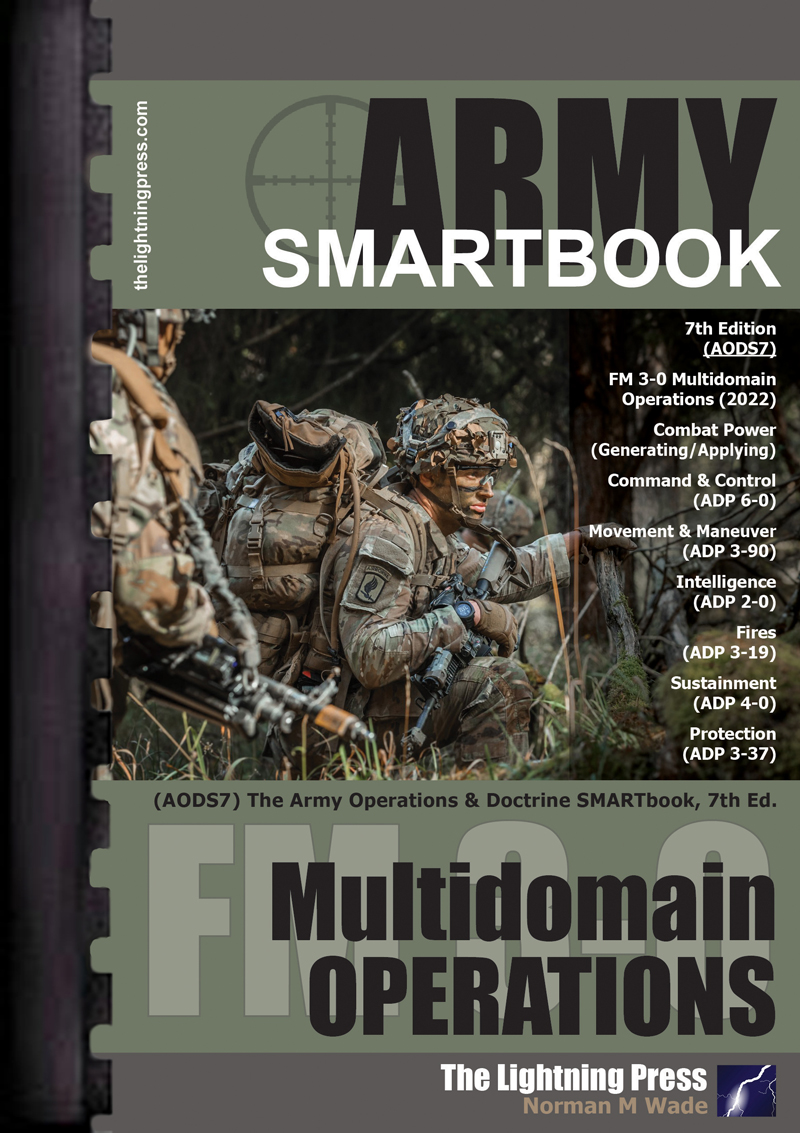
AODS7: The Army Operations & Doctrine SMARTbook, 7th Ed.
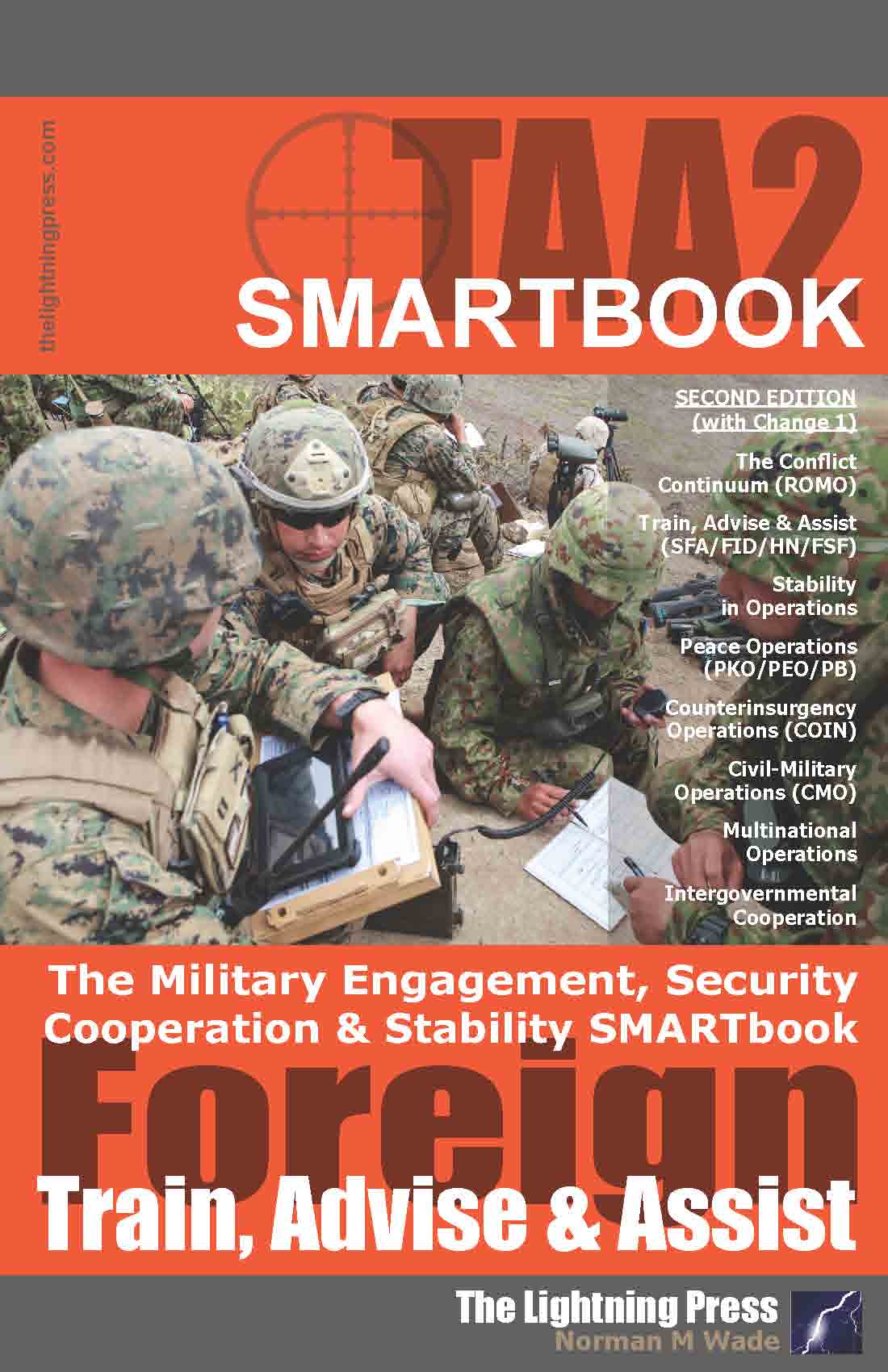
TAA2: The Military Engagement, Security Cooperation & Stability SMARTbook, 2nd Ed. (w/Change 1)
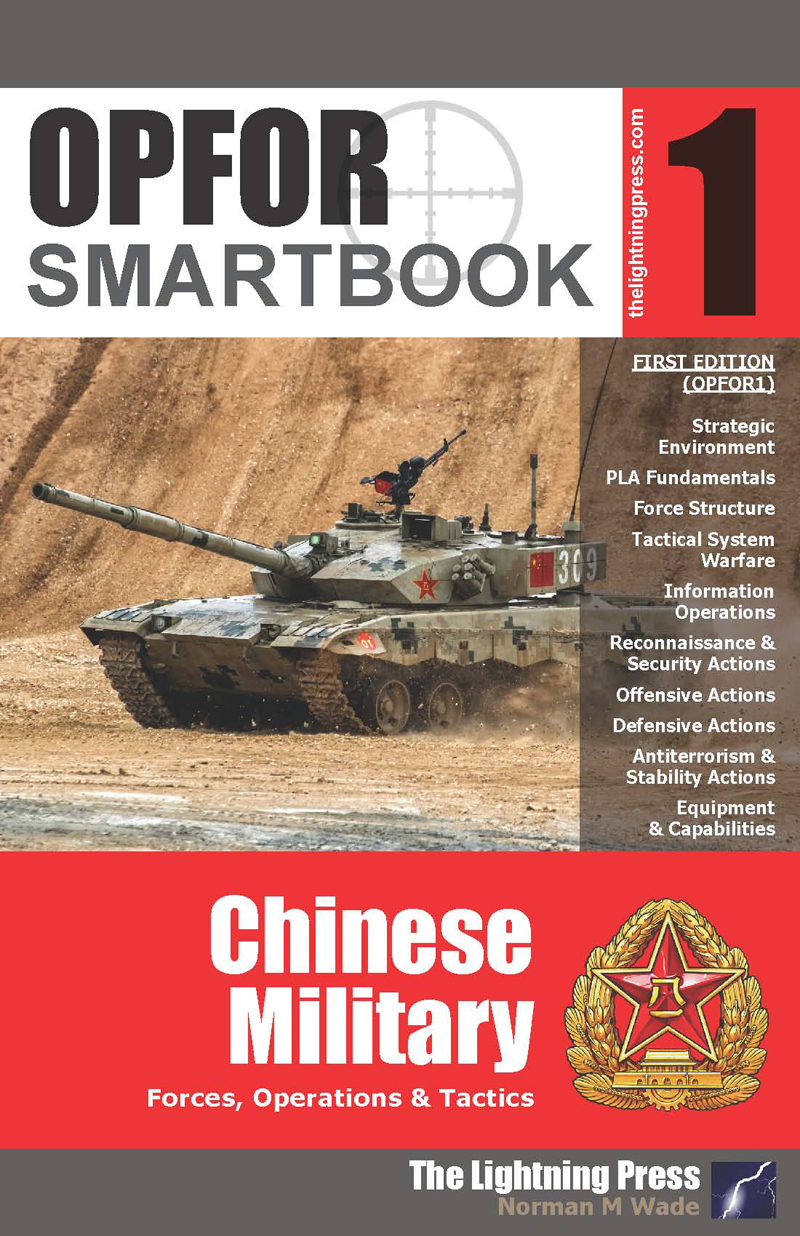
OPFOR SMARTbook 1 - Chinese Military
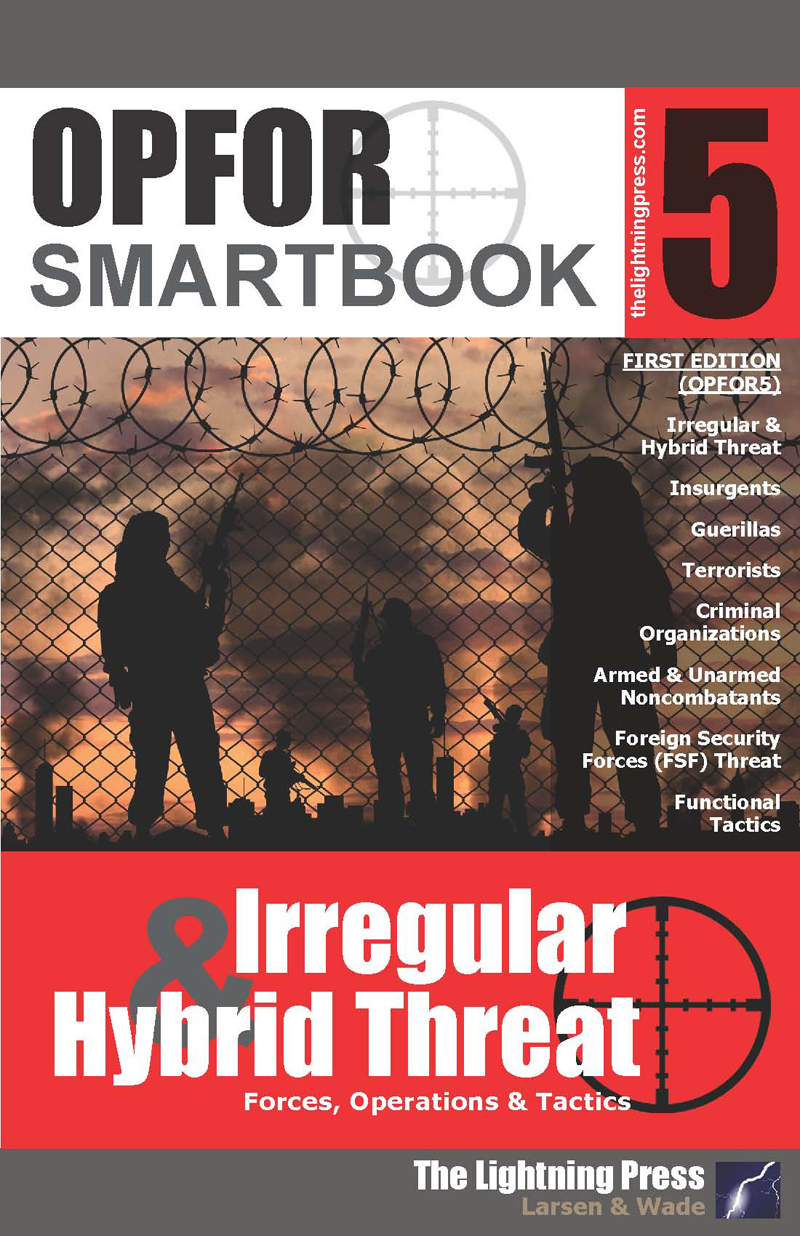
OPFOR SMARTbook 5 - Irregular & Hybrid Threat
The Leader's SMARTbook, 4th Rev. Ed. (PREVIOUS EDITION)

Release Note :Jan 2014
Norman M. Wade
Binding Type:Plastic Comb
Print Inside Pages:Black and White
Trim Size:5.5'' x 8.5''
Total Pages:308
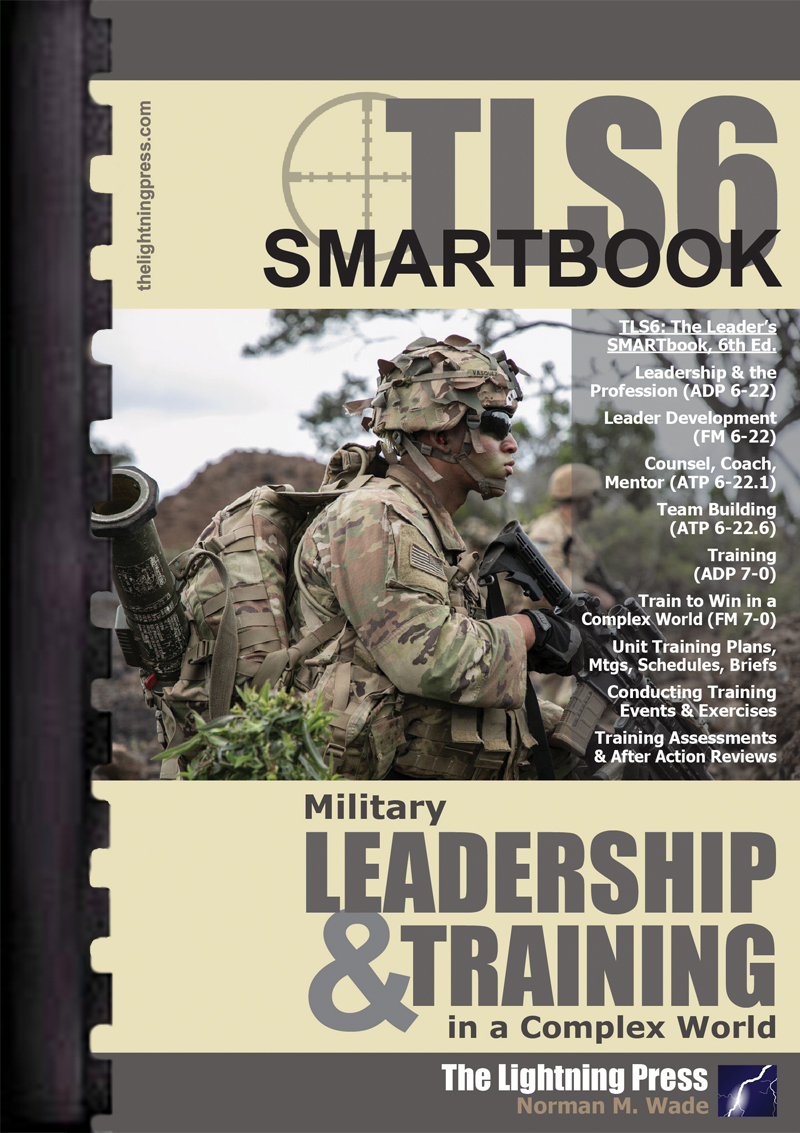
A NEW edition of this book is available!
TLS6: The Leader’s SMARTbook, 6th Ed. (PREVIOUS EDITION)
Upgrade/update to the NEW 7th Edition (TLS7)!
Upgrade/update to the NEW edition! TLS4: The Leader's SMARTbook, 4th Rev. Ed. (May 2015) has been superseded by a newer edition TLS6 (Mar 2021). Always check our website for the most current and up-to-date SMARTbook edition! The Lightning Press is committed to providing the best and most relevant doctrinal material to our readers and are vigilant in reviewing new publications, anticipating upcoming doctrinal releases, and incorporating the updated material into our SMARTbook series! Click "View New Edition" above to browse the new edition!TLS6 is the sixth edition of The Leader’s SMARTbook, completely updated for 2021. TLS6 incorporates the full scope of new material from ADP 6-22 Army Leadership and the Profession (with Change 1), ADP 7-0 Training, and FM 7-0 Train to Win in a Complex World. Jam-packed at 392 pages, topics and chapters include military leadership (ADP 6-22); leader development (FM 6-22); coach, counsel, and mentor (ATP 6-22.1), team building; (ATP 6-22.6), military training (ADP 7-0), train to win in a complex world (FM 7-0); unit training plans, meetings, schedules, briefs; conducting training events and exercises; training assessments, evaluations and after action reviews.
Related Books
TLS7: The Leader’s SMARTbook, 7th Ed.
ISBN-10 :1-935886-95-9
Release Date :Aug 1st, 2023
Norman M. Wade
Binding Type:Plastic Comb
Print Inside Pages:Black and White
Trim Size:5.5'' x 8.5''
Total Pages:328

Paperback Edition
Price: $42.95 $36.95

Bundle & Save (Paperback + Digital)
Price: $85.90 $49.95
Leadership as a Dynamic of Combat Power
TLS7 is the seventh edition of The Leader’s SMARTbook, completely updated for 2023. TLS7 focuses on gaining the human advantage and leadership as a dynamic of combat power (FM 3-0, 2022), developing leaders, and training, the most important thing the Army does to prepare for operations. Topics and chapters include Army leadership and the profession (ADP 7-0); developing leaders (FM 6-22); counseling, coaching, and mentoring (ATP 6-22.1); Army team building (ATP 6-22.6); training to fight and win (ADP 7-0 / FM 7-0 / FM 7-22); planning & preparation: training guidance, meetings, schedules, briefs; executing training events and exercises, holistic health & fitness (H2F); training evaluations, assessments, and after action reviews.
Combat power is the total means of destructive and disruptive force that a military unit/formation can apply against an enemy at a given time. It is the ability to fight.
Leadership is the most essential dynamic of combat power. Leadership is the activity of influencing people by providing purpose, direction, and motivation to accomplish the mission and improve the organization.
The human dimension encompasses people and the interaction between individuals and groups, how they understand information and events, make decisions, generate will, and act within an operational environment. A human advantage occurs when a force holds the initiative in terms of training, morale, perception, and will.
Today’s Army demands trained and ready units with agile, proficient leaders. Army leaders are the competitive advantage the Army possesses that neither technology nor advanced weaponry and platforms can replace. Developing leaders is a complex and complicated undertaking because it is primarily a human endeavor—requiring constant involvement, assessment, and refinement.
The Army relies on effective teams to perform tasks, achieve objectives, and accomplish missions. Building and maintaining teams that operate effectively is essential. Team building is a continuous process of enabling a group of people to reach their goals and improve their effectiveness through leadership and various exercises, activities, and techniques.
The Army trains to fight and win—it is what we do in order to preserve the peace and to decisively defeat our enemies. We do this through challenging, relevant, and realistic training performed to the highest standards. The Army trains the way it operates. It does this by replicating in training how we expect to fight,closing the gap between operations and training.
To do this, the Army trains by developing proficiencies in mission-essential tasks, weapon systems, and the effective integration and employment of both. These components of training readiness provide the backbone to the development of unit readiness—the Army’s first priority.
Related Books
Discount sets with this book
SUTS3: The Small Unit Tactics SMARTbook, 3rd Ed.
ISBN-10 :1-935886-77-0
Release Date :Mar 1st, 2020
Cover Type:Gloss U.V. Coating
Binding Type:Plastic Comb
Print Inside Pages:Black and White
Trim Size:5.5'' x 8.5''
Total Pages:344

Paperback Edition
Price: $42.95 $36.95

Bundle & Save (Paperback + Digital)
Price: $85.90 $49.95
Planning & Conducting Tactical Operations
SUTS3: The Small Unit Tactics SMARTbook, 3rd Ed. is the third revised edition of The Small Unit Tactics SMARTbook, completely updated for 2019 to include ADP 3-90 Offense and Defense (Jul ‘19), FM 3-0 Operations w/Change 1 (Dec ‘17), FMs 3-90-1 & -2 (May ‘13), ATP 3-21.8 Infantry Platoon and Squad (Apr ‘16), ATP 3-21.10 Infantry Rifle Company (May ‘18), TC 3-21-76 The Ranger Handbook (Apr ‘17), and the latest versions of more than 20 additional references. SUTS3 also features a return of our premium GBC plastic-comb binding for a true open-flat reference experience!
At 344-pages, chapters and topics include tactical mission fundamentals, the offense, the defense, stability and counterinsurgency operations, tactical enabling tasks (security, reconnaissance, relief in place, passage of lines, encirclement, and troop movement), special purpose attacks (ambush and raid), urban and regional environments (urban, fortified areas, desert, cold region, mountain, and jungle operations), patrols and patrolling.
Tactics is the employment and ordered arrangement of forces in relation to each other. Through tactics, commanders use combat power to accomplish missions. The tactical-level commander uses combat power in battles, engagements, and small-unit actions.
The nature of close combat in land operations is unique. Combatants routinely come face-to-face with one another in large numbers in a wide variety of operational environments comprising all types of terrain. When other means fail to drive enemy forces from their positions, forces close with and destroy or capture them.
Offensive actions are combat operations conducted to defeat and destroy enemy forces and seize terrain, resources, and population centers. They impose the commander’s will on the enemy. A commander may also conduct offensive actions to deprive the enemy of resources, seize decisive terrain, deceive or divert the enemy, develop intelligence, or hold an enemy in position. The four primary offensive tasks are movement to contact, attack, exploitation, and pursuit.
A defensive task is a task conducted to defeat an enemy attack, gain time, economize forces, and develop conditions favorable for offensive or stability tasks. Although on the defense, the commander remains alert for opportunities to attack the enemy. A defending force does not wait passively to be attacked, aggressively seeking ways of attriting and weakening enemy forces before close combat begins. There are three basic defensive tasks—area defense, mobile defense, and retrograde.
The Small Unit Tactics SMARTbook translates and bridges operational-level doctrine into tactical application -- in the form of tactics, techniques and procedures -- and provides the “how to” at the small-unit level as a ready reference at the battalion, company, platoon, squad and fire team level.
Related Books
Discount sets with this book
AODS7: The Army Operations & Doctrine SMARTbook, 7th Ed.
ISBN-10 :1935886916
Release Date :Mar 1st, 2023
Norman M. Wade
Binding Type:Plastic Comb
Print Inside Pages:Black and White
Trim Size:5.5'' x 8.5''
Total Pages:352

Paperback Edition
Price: $42.95 $36.95

Bundle & Save (Paperback + Digital)
Price: $85.90 $49.95
Multidomain Operations
AODS7: The Army Operations & Doctrine SMARTbook, 7th Ed. (Multidomain Operations) is completely updated with the 2022 edition of FM 3-0. AODS7 focuses on Multidomain Operations and features rescoped chapters on generating and applying combat power: command & control (ADP 6-0), movement and maneuver (ADPs 3-90, 3-07, 3-28, 3-05), intelligence (ADP 2-0), fires (ADP 3-19), sustainment (ADP 4-0), & protection (ADP 3-37).
The Army’s primary mission is to organize, train, and equip its forces to conduct prompt and sustained land combat to defeat enemy ground forces and seize, occupy, and defend land areas. Army forces shape operational environments, counter aggression on land during crisis, prevail during large-scale ground combat, and consolidate gains.
Army forces achieve objectives through the conduct of operations. Operations vary in many ways. They occur in all kinds of physical environments and vary in scale of forces involved and duration.
Multidomain operations are the combined arms employment of joint and Army capabilities to create and exploit relative advantages that achieve objectives, defeat enemy forces, and consolidate gains on behalf of joint force commanders. Multidomain operations are the Army’s contribution to joint campaigns, spanning the competition continuum.The Army provides forces capable of transitioning to combat operations, fighting for information, producing intelligence, adapting to unforeseen circumstances, and defeating enemy forces. Army forces employ capabilities from multiple domains in a combined arms approach that creates complementary and reinforcing effects through multiple domains while preserving combat power to maintain options for the joint force commander.
Combat power is the total means of destructive and disruptive force that a military unit/formation can apply against an enemy at a given time. It is the ability to fight. The complementary and reinforcing effects that result from synchronized operations yield a powerful blow that overwhelms enemy forces and creates friendly momentum. Army forces deliver that blow through a combination of five dynamics: leadership, firepower, information, mobility, and survivability.
The warfighting functions contribute to generating and applying combat power. Well sustained units able to move and maneuver bring combat power to bear against the opponent. Joint and Army indirect fires complement and reinforce organic firepower in maneuver units. Survivability is a function of protection tasks that focus friendly strengths against enemy weaknesses. Information contributes to the disruption and destruction of enemy forces. Intelligence determines how and where to best apply combat power against enemy weaknesses. C2 enables leadership, the most important qualitative aspect of combat power.
Note: AODS7: The Army Operations & Doctrine SMARTbook (Multidomain Operations) is designed specifically to work hand-in-hand as a planner’s companion guide to BSS7: The Battle Staff SMARTbook, 7th Ed., with specific page references that lead to expanded content pertinent to understanding multidomain operations from FM 3-0. Save $14.90 when you order both together (bundle the print and digital versions together and save $74.80)! Read more here: https://www.thelightningpress.com/bookstore/smartset/multidomain-ops-planning-set-2-books/
Related Books
Discount sets with this book
TAA2: The Military Engagement, Security Cooperation & Stability SMARTbook, 2nd Ed. (w/Change 1)
ISBN-10 :193588669X
Release Date :Jan 1st, 2018
Binding Type:Perfect Bind
Print Inside Pages:Black and White
Trim Size:5.5'' x 8.5''
Total Pages:392
UPGRADE / CONVERT this book to premium GBC Plastic-Comb binding!
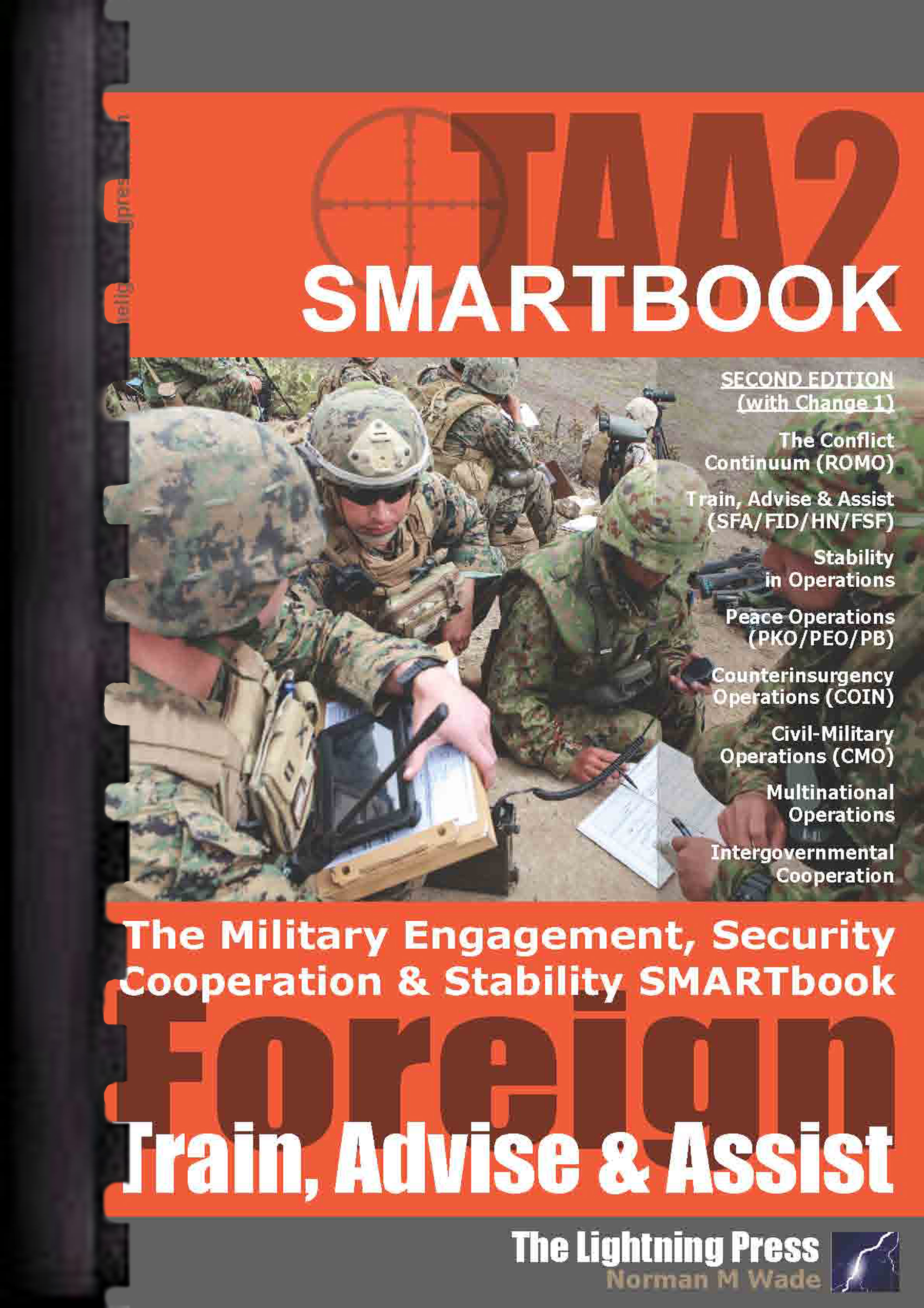

Paperback Edition
Price: $42.95 $36.95

Bundle & Save (Paperback + Digital)
Price: $85.90 $49.95
Train, Advise, & Assist
TAA2: The Military Engagement, Security Cooperation & Stability SMARTbook (with Change 1*) is the re-titled and re-focused second edition of The Stability, Peace & Counterinsurgency SMARTbook. Topics and references include the Range of Military Operations (JP 3-0); Train, Advise & Assist (SFA/FID/IDAD/HN/FSF); Stability Operations (JP & ADRP 3-07); Peace Operations (JP & FM 3-07.3); Counterinsurgency Operations (JP & FM 3-24); Civil-Military Operations (JP 3-57); Multinational Operations (JP 3-16); and Interorganizational Cooperation (JP 3-08).
* Change 1 to TAA2 (Sept 2017) incorporates new material and text edits from JP 3-0 (Jan 2017), JP 3-07 (Aug 2016), JP 3-20 (May 2017), JDN 1-3 (Apr 2013), and JP 3-08 (Oct 2016). An asterisk marks changed pages.
In the complex, dynamic operational environments of the 21st century, significant challenges to sustainable peace and security exist. Sources of instability that push parties toward violence include religious fanaticism, global competition for resources, climate change, residual territorial claims, ideology, ethnic tension, elitism, greed, and the desire for power. These factors create belts of state fragility and instability that threaten U.S. national security.
Throughout U.S. history, U.S. forces have learned that military force alone cannot secure sustainable peace. U.S. forces can only achieve sustainable peace through a comprehensive approach in which military objectives nest in a larger cooperative effort of the departments and agencies of the U.S. Government, intergovernmental and nongovernmental organizations, multinational partners, the private sector, and the host nation.
Military engagement, security cooperation, and stability missions, tasks, and actions encompass a wide range of actions where the military instrument of national power is tasked to support OGAs and cooperate with IGOs (e.g., UN, NATO) and other countries to protect and enhance national security interests, deter conflict, and set conditions for future contingency operations.
Use of joint capabilities in these and related activities such as Security Force Assistance and Foreign Internal Defense helps shape the operational environment and keep the day-to-day tensions between nations or groups below the threshold of armed conflict while maintaining US global influence.
Stability operations are various military missions, tasks, and activities conducted outside the US in coordination with other instruments of national power to maintain or reestablish a safe and secure environment, provide essential governmental services, emergency infrastructure reconstruction, and humanitarian relief.
Peace Operations are crisis response and limited contingency operations conducted by a combination of military forces and nonmilitary organizations to contain conflict, redress the peace, and shape the environment to support reconciliation and rebuilding and to facilitate the transition to legitimate governance.
A counterinsurgency campaign is a mix of offensive, defensive, and stability operations conducted along multiple lines of operations. It requires military forces to employ a mix of familiar combat tasks and skills more often associated with nonmilitary agencies and to be nation builders as well as warriors.
Civil-military operations are a primary military instrument to synchronize military and nonmilitary instruments of national power, particularly in support of stability, counterinsurgency and other operations dealing with asymmetric and irregular threats.
Related Books
Discount sets with this book
OPFOR SMARTbook 1 - Chinese Military
ISBN-10 :1-935886-55-X
Release Date :Aug 9th, 2022
Norman M. Wade
Binding Type:Perfect Bind
Print Inside Pages:Black and White
Trim Size:5.5'' x 8.5''
Total Pages:312
UPGRADE / CONVERT this book to premium GBC Plastic-Comb binding!
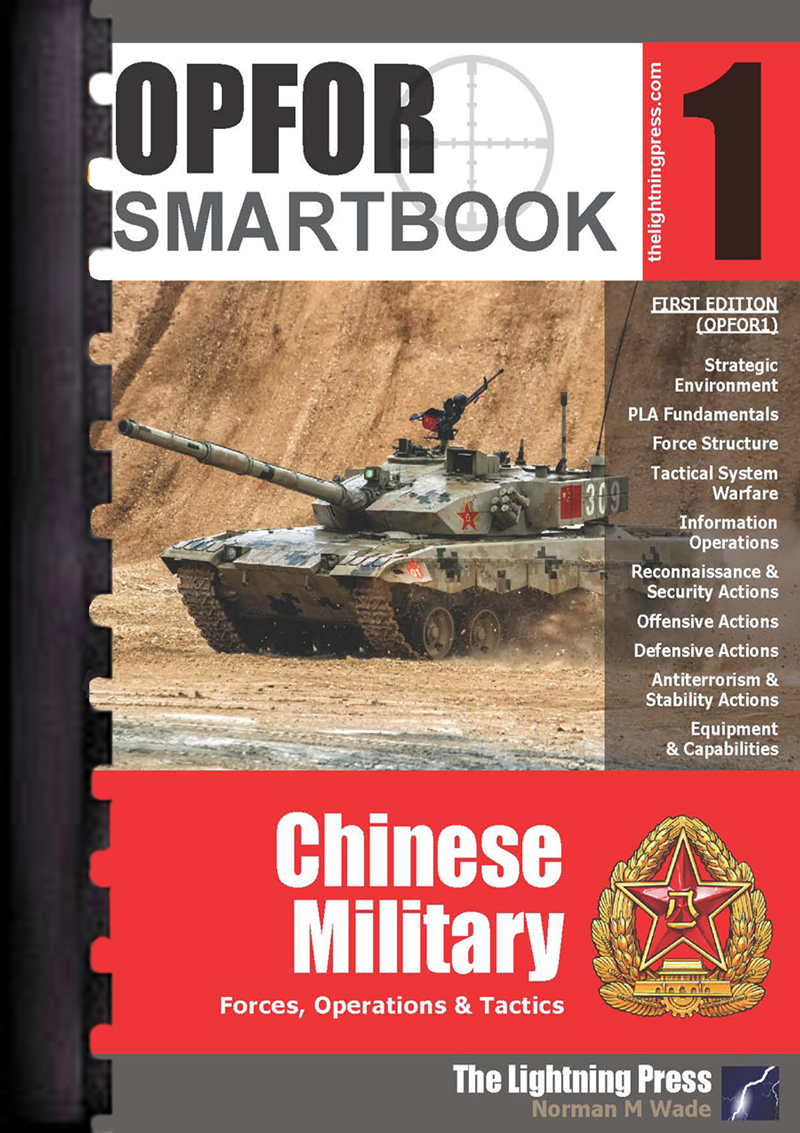

Paperback Edition
Price: $42.95 $36.95

Bundle & Save (Paperback + Digital)
Price: $85.90 $49.95
Chinese Forces, Operations & Tactics
OPFOR1 topics and chapters include the strategic environment (understanding China, defense & military strategy, strategic & operational environments, territorial disputes), force structure (PLA: Army, Navy, Marine, Air Force, Rocket Force, Strategic Support Force), system warfare, information operations, reconnaissance and security, offensive and defensive actions, antiterorrism and stability actions, equipment and capabilities (maneuver, fire support, air defense, aviation, engineer and chemical defense, network and communications, and special operations forces).
For over two thousand years, China has been surrounded by enemies, adversaries, and other competitors. Invasion, occupation, raids, and other incursions into Chinese territory were commonplace. The People’s Liberation Army (PLA) views protecting Chinese sovereignty and security as a sacred duty. China traditionally viewed military resistance as an affair for the entire population: mass resistance, guerrilla warfare, and winning a war of attrition.
The People’s Liberation Army Army (PLAA) has approximately 975,000 active-duty personnel in combat units. The PLAN is the largest navy in the world with a battle force of approximately 355 platforms, including major surface combatants, submarines, aircraft carriers, ocean-going amphibious ships, mine warfare ships, and fleet auxiliaries. The Air Force (PLAAF) and PLAN Aviation together constitute the largest aviation forces in the region and the third largest in the world, with over 2,800 total aircraft (not including trainer variants or UAVs) of which approximately 2,250 are combat aircraft (including fighters, strategic bombers, tactical bombers, multi-mission tactical, and attack aircraft). The PLA Rocket Force (PLARF) is the largest missile force in the world, operating well over 1,000 short-range, medium-range, and intercontinental ballistic missiles (ICBMs) and over 300 long-range cruise missiles.
With a force that totals approximately two million personnel in the regular forces, the PLA has sought to modernize its capabilities and improve its proficiencies across all warfare domains so that as a joint force it can conduct the range of land, air, and maritime operations as well as space, counterspace, electronic warfare (EW), and cyber operations. Recognizing that joint operations, information flows, and rapid decision-making are vital in modern warfare, the PRC continues to place a high priority on modernizing the PLA’s capability to command complex joint operations in near and distant battlefields.
The PRC has stated its defense policy aims to safeguard its national sovereignty, security, and development interests. China’s leaders view these interests as foundational to their national strategy. In 2020, the PRC’s defense policy and military strategy primarily oriented the PLA towards “safeguarding” its perceived “sovereignty and security” interests in the region counter the United States. At the same time, China’s leaders increasingly cast the armed forces as a practical instrument to defend Beijing’s expanding global interests and to advance its foreign policy goals within the framework of “Major Power Diplomacy with Chinese Characteristics.”
Related Books
Discount sets with this book
OPFOR SMARTbook 5 - Irregular & Hybrid Threat
ISBN-10 :1-935886-54-1
Release Date :Aug 9th, 2022
Cover Type:Gloss U.V. Coating
Binding Type:Perfect Bind
Print Inside Pages:Black and White
Trim Size:5.5'' x 8.5''
Total Pages:282
UPGRADE / CONVERT this book to premium GBC Plastic-Comb binding!
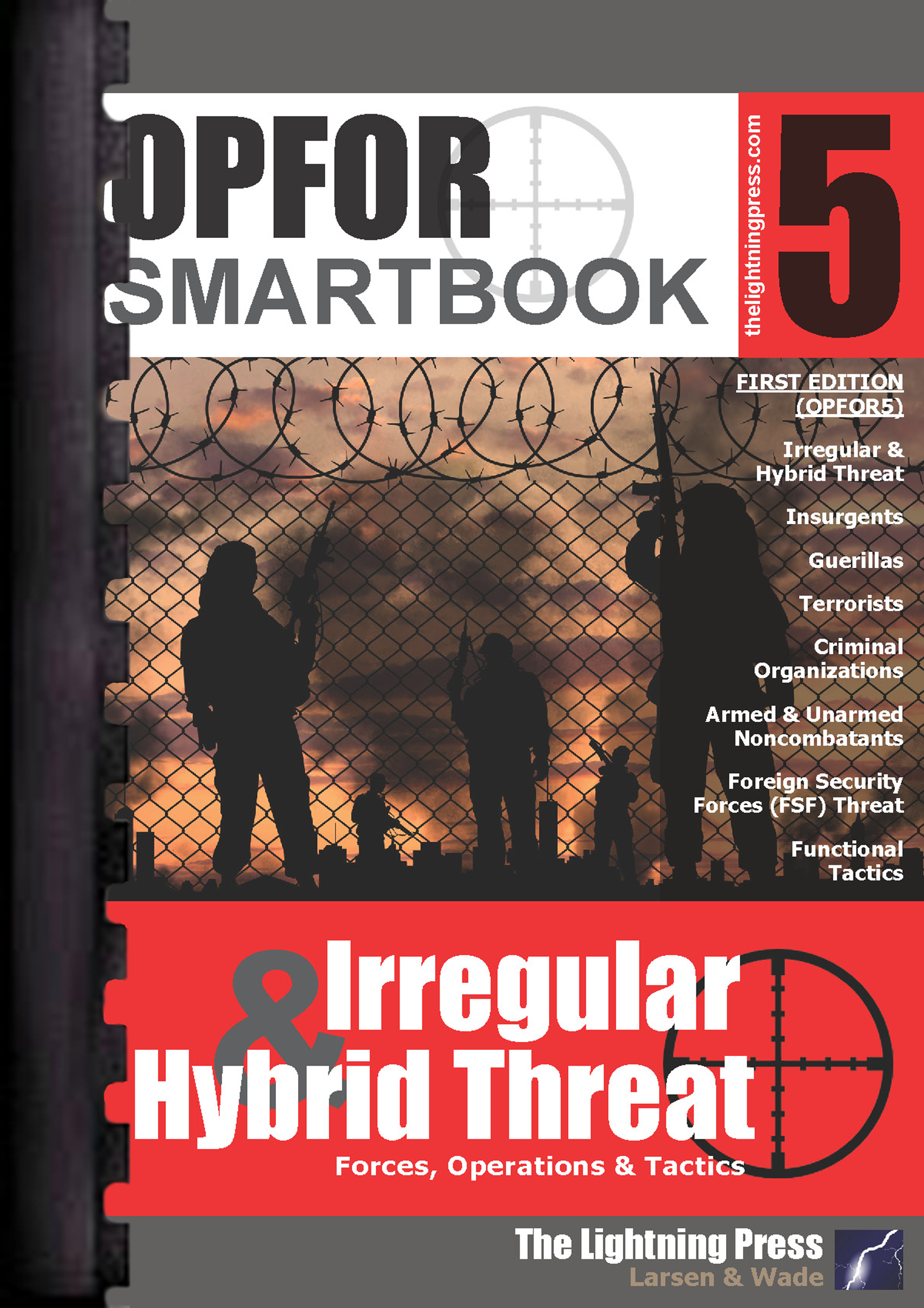

Paperback Edition
Price: $42.95 $36.95

Bundle & Save (Paperback + Digital)
Price: $85.90 $49.95
Irregular & Hybrid Threat Forces, Operations & Tactics
OPFOR5 topics and chapters include irregular and hybrid threat (components, organizations, strategy, operations, tactics), insurgents and guerillas forces (characteristics, organizations, TTPs), terrorists (motivations, behaviors, organizations, operations and tactics), criminals (characteristics, organizations, activities), noncombatants (armed & unarmed), foreign security forces (FSF) threats, and functional tactics.
A hybrid threat is the diverse and dynamic combination of regular forces, irregular forces, and/or criminal elements all unified to achieve mutually benefitting effects. The term “hybrid” has recently been used to capture the seemingly increased complexity of war, the multiplicity of actors involved, and the blurring between traditional categories of conflict. While the existence of innovative adversaries is not new, today’s hybrid approaches demand that U.S. forces prepare for a range of conflicts.
Irregular forces are armed individuals or groups who are not members of the regular armed forces, police, or other internal security forces.The irregular OPFOR can be part of the hybrid threat (HT). The irregular OPFOR component of the HT can be insurgents, guerrillas, or criminals or any combination thereof. The irregular OPFOR can also include other armed individuals or groups who are not members of a governing authority’s domestic law enforcement organizations or other internal security forces.
Irregular forces are unregulated and as a result act with no restrictions on violence or targets for violence. Time-honored concepts of “conventional” and “unconventional” war and “traditional” methods versus “adaptive” methods are weapons to a hybrid threat. One of the most significant capabilities of the irregular OPFOR is the ability to manipulate and/or ignore the restrictions and sanctions that apply to regulated military forces, law enforcement agencies, and internal security forces belonging to a sovereign state. The ability to combine and transition between regular and irregular forces and operations to capitalize on perceived vulnerabilities makes hybrid threats particularly effective.
Insurgents are armed and/or unarmed individuals or groups who promote an agenda of subversion and violence that seeks to overthrow or force change of a governing authority.
A guerrilla force is a group of irregular, predominantly indigenous personnel organized along military lines to conduct military and paramilitary operations in enemy-held, hostile, or denied territory.
Terrorism is a tactic. Terrorism can be defined as the use of violence or threat of violence to instill fear and coerce governments or societies. Often motivated by philosophical or other ideological beliefs, objectives are typically political in nature.
Criminal elements exist at every level of society and in every operational environment (OE). Their presence, whatever their level of capabilities, adds to the complexity of any OE.
A host of noncombatants add complexity to any operational environment. Noncombatants are persons not actively participating in combat or actively supporting of any of the forces involved in combat. They can be either armed or unarmed. The irregular OPFOR attempts to manipulate these noncombatants in ways that support its goals and objectives.
Foreign security forces (FSF) are those forces, including, but not limited to military, paramilitary, police, and intelligence forces; border police, coast guard, and customs officials; and prison guards and correctional personnel, that provide security for a host nation and its relevant population or support a regional security organization’s mission. An FSF threat attack is a violent act perpetrated against a U.S. Service member, civilian, or contractor by a FSF member or members who have access to U.S. Service members, civilians, or contractors. The FSF threat is not a new phenomenon; however, during recent limited contingency operations, U.S. forces experienced a sharp increase in the number of attacks perpetrated by FSFs.
Insurgents and guerrillas, as part of the irregular OPFOR, may employ adaptive functional tactics. When planning a tactical action, an irregular OPFOR commander or leader determines what functions must be performed to accomplish the mission. Then he allocates functional responsibilities to his subordinates and synchronizes the effort.
Related Books
Discount sets with this book













